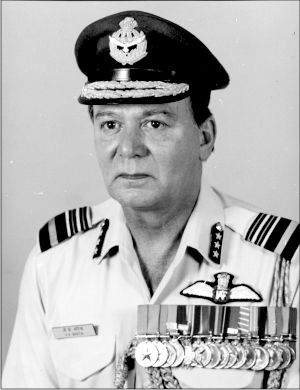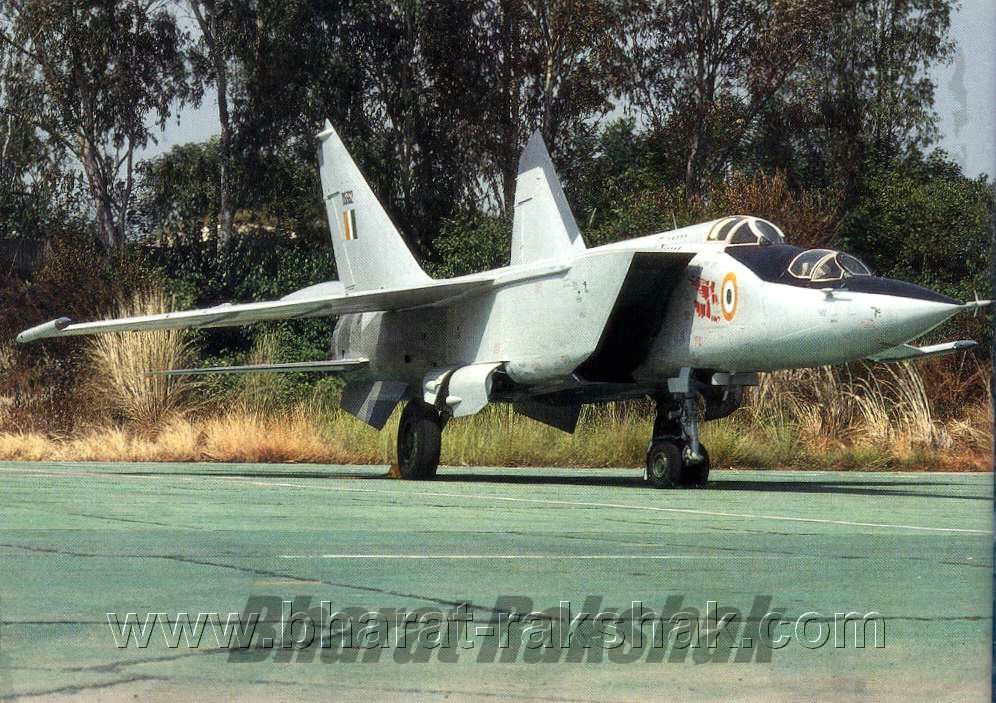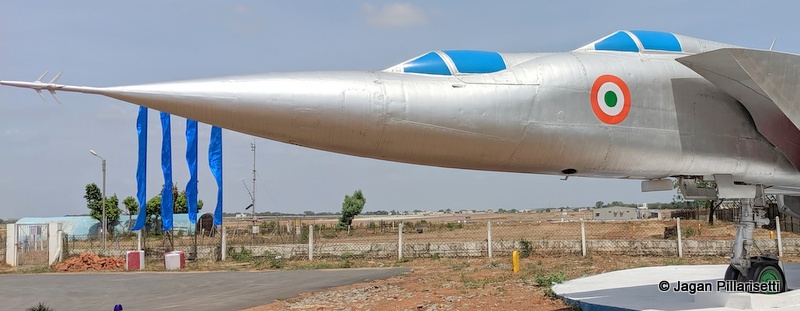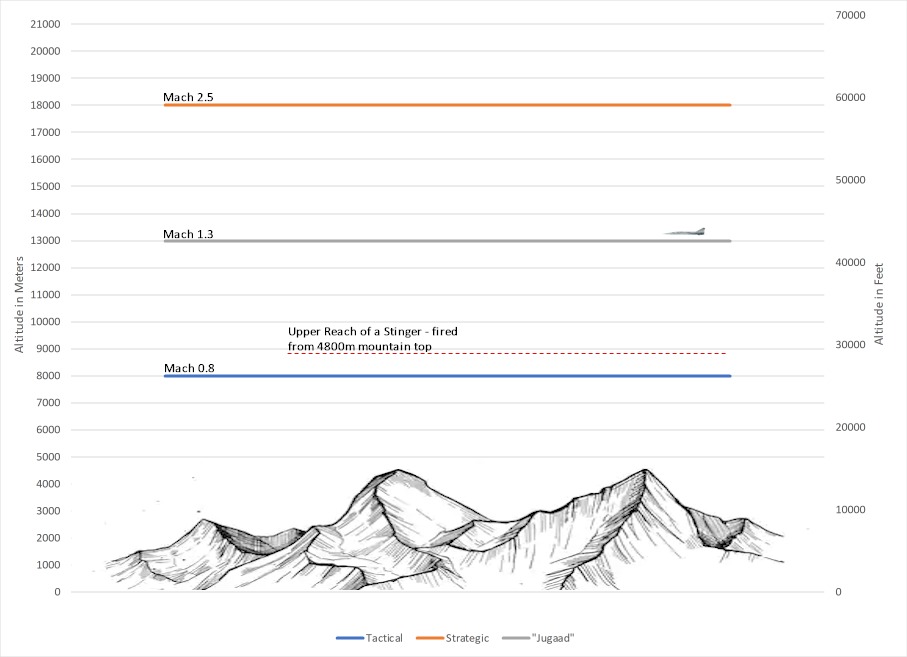Air Marshal Vinod Kumar “Jimmy” Bhatia, PVSM AVSM VrC Bar , 6497 F(P) was the Air Officer Commanding-in-Chief during the Kargil conflict. A veteran of two wars against Pakistan – he was one of the few senior ranking officers to fly operational missions during the Kargil Conflict in 1999. This is his story of how Central Air Command utilized the MiG-25 Foxbat in a photo recce role at a profile for which the aircraft was not designed for.

Air Marshal Vinod Kumar “Jimmy” Bhatia, PVSM AVSM VrC Bar , 6497 F(P) was the Air Officer Commanding-in-Chief during the Kargil conflict. A veteran of two wars against Pakistan – he was one of the few senior ranking officers to fly operational missions during the Kargil Conflict in 1999. This is his story of how Central Air Command utilized the MiG-25 Foxbat in a photo recce role at a profile for which the aircraft was not designed for.
One of the major difficulties encountered by the IAF during air operations in the 1999 Kargil War was on how to acquire enemy targets in the areas of intrusion for attacks by fighters. While the enemy’s major logistics camps were located in the valleys, its combat forces were perched up on mountain tops ranging at heights between 4,500 and 5,500 metres amsl. Enemy troops had ensconced themselves in ‘Sangars’ which were nothing else but bunkers created out of rocks that merged with the surrounding terrain in a perfect camouflage and were hardly visible to the naked eye – even from close ranges.
Picking up these targets from the air at jet speeds was well nigh impossible unless their exact locations were known in relation to other discernible landmarks and pilots duly briefed prior to undertaking strike missions. IAF had little information of the targets being provided skeletally the Army/RAW sources and decided to induct its own reconnaissance aircraft for the purpose.
But, with a No. 106 Squadron ‘Recce’ Canberra picking up an early hit by enemy shoulder-fired missile put paid to this endeavour, even though the stricken aircraft had managed to limp back and safely landed at the nearest IAF base at Srinagar. Use of Jaguars with their underslung recce pods that were optimised for only low-level photography to get desirable highresolution results was also abandoned due to their vulnerability to shoulderfired SAMs that had been deployed at practically all the enemy posts in the conflict zone.

|
“Well, the photographs of the mountains and the terrain in the Kargil sector (15-18,000 ft) during the Indo-Pak Kargil conflict of 1999 are testimony to the photographic quality obtained from the MiG-25R. Every ridge, every crevasse, every approach and defile was clearly defined, all enemy positions and bunkers in the craggy and inhospitable mountain ranges lay exposed, providing immense information to the Indian Army and the IAF to conduct successful operations.” – Air Marshal Sumit Mukherji (Retd), a former CO of No. 102 Squadron.
|
Naturally, IAF was almost at a dead end on how to solve the problem when an idea struck this writer, in the classic tradition of IAF Jugaad’ (Read Improvisation): Why not try out the MiG-25 with its powerful cameras to pick up enemy targets in the Kargil Heights while staying out of harm’s way from the enemy SAMs by flying at a safe height?
No. 102 Squadron equipped with MiG-25s was the only trisonic Strategic Reconnaissance (SR) squadron with a handful of MiG-25 aircraft in the IAF that was based at Bareilly – one of the fighter bases under me as AOC-in-C, Central Air Command. The aircraft had been acquired from the Soviet Union in 1980s and was the second fastest manned aircraft in the world after the US SR-71 Blackbird. It was basically meant for SR missions to be flown at near Mach 3 speeds at heights in the region of 20,000 m to make it literally immune to all known enemy air defence systems at the time.
But, these high-speed/high-altitude missions were for strategic area photography, and even the 72-inch focal-length cameras of MiG-25 were not powerful enough to provide the kind of resolution needed to pick out ‘sangar’ type of targets from the snowy background of Kargil heights. Pilots of the ‘Trisonics’ squadron had been actually practicing two recce profiles on the big bird: one was the standard Mach 2.5+ run at 18-20 km amsl height with full afterburners on both engines and the other at 0.8 Mach subsonic speed at 8 km amsl height in dry power for tactical reconnaissance. The latter profile would have given the necessary resolution for the photointerpreters to be able to locate the enemy positions, but for obvious reasons of vulnerability, could not be flown in Kargil area where the SAM infested enemy positions were located at an average height of 5,000m above sea level which would have brought the MiGs within the SAMs lethal zones.
The solution lay in flying at 13 km amsl which would give a safe 8 km agl (above ground level) height, conforming to the in-practice subsonic profile while, at the same time ensuring high-res, interpretable photos to locate enemy positions.
However, there was a catch to this proposal as at 13 km MiG-25 could not be flown in dry power alone. The optimum way out of this problem appeared to be to use minimum reheat (after burners) at this height which would have given around M 1.3 and sufficient IAS (Indicated Air Speed) to sustain stable flight with reasonably good photo-overlap to prepare a mosaic, if required.
A chart showing the approved “Profiles” of the MiG-25 Operations – and the “Jugad” profile that Central Air Command had to come up with just for Kargil – flying at Mach 1.3 at an altitude of 42000 feet would put it above the range of the Stinger missiles that could be fired from the mountain tops.
Buoyed with the idea, I immediately went to Delhi to discuss it with the then CAS, Air Chief Marshal Tipnis at Air HQ for implementation. In spite of the grave skepticism expressed by some during the discussions that followed, especially with regard to the stable engine operation in minimum reheat regime (ostensibly prohibited in the Russian manuals), I was able to get a onetime waiver from the Chief to try out the idea.
The very next day, I flew to Bareilly from where a two-seater MiG-25 was waiting for me with loaded cameras to try out the experiment. I was in the front cockpit in the nose section of the massive aircraft. The sortie was flown as planned; with throttles retarded to min reheat stops at 13 km height. The aircraft settled down at Mach 1.3 in a stable flight with engines purring smoothly. We flew for quite some time to check the engines’ behaviour when flying with min reheat for prolonged periods. When fully satisfied with theIr stable operation, we landed back at Bareilly. The Sqn gave me an album of photographs which had been taken earlier during practice missions flown on the single-seater with cameras at 8 km AGL to demonstrate the kind of resolution which was possible, that would enable interpretation of even heavily camouflaged targets, such as ‘Sangars’ on the Kargil sector’s icy heights.
The album was shown to the Chief in Delhi the same evening while confirming the viability of the rather unusual but utterly safe mission profile. This cleared the way for the Foxbats to be gainfully utilised for PR missions during the Kargil War. The rest, as can be confirmed by the photographs adorning the walls of the ‘Operations Room’ in Western Air Command (WAC), is history.

Jimmy Bhatia’s Logbook excerpt showing the entry for the MiG-25U sortie flown on June 17th, 1999. The aircraft being DS-361 with Wg Cdr P K Sharan in the front cockpit. After retirement Foxbat DS-361 is currently on display at Air Force Station Kalaikunda.

Close up of a MiG-25 two-seater – this example being DS-362 now on display at Air Force Academy in Dundigal.
This article was first published in “India Strategic” magazine. Reproduced here with the Author’s permission
Other Links:
- Walkaround Gallery of Foxbat DS-362 http://www.bharat-rakshak.com/IAF/Galleries/Aircraft/Walkarounds/MiG25U/
- MiG-25 History and Data Page http://www.bharat-rakshak.com/IAF/aircraft/specs/563-mig-25r.html
- The MIGnificient Flying Machines http://www.bharat-rakshak.com/IAF/aircraft/past/963-mig25.html
Editor’s Note: We have received various queries on this article that we feel compelled to explain – In the article, the author gives details of a “Proving Flight” over Barielly area – and not actually over the Kargil Battle area. Additionally, the claim that the MiG-25U took photographs is still in contradiction with what we know about the type – that the two-seater does not carry cameras.
Additionally, the photo caption on DS-362 originally claimed there was a Camera Port on the Trainer variant. The “Port” under the cockpit is actually that of light. That caption identifying it as a camera port is a mistake by the editor of this site.
The following comments were made on an earlier version of the article by Air Marshal Sumit Mukerji (who is quoted in the above article). They are reproduced below to add clarity to some of the aspects:
As one of the erstwhile COs of The Trisonics with 6 yrs of experience and more than 700 hrs on the MiG-25, kindly let me elucidate and point out some factual errors in the article.
- Standard profile of the MiG-25 was at M 2.4 + at altitudes 20 Kms + (started around 20 Kms, then the aircraft cruise climbed as the fuel reduced. Generally we finished around 22 Kms or so. THIS WAS DONE AT MINIMUM AFTERBURNER (and NOT(R)NOT AT MAX AFTERBURNER). Max afterburner was to get-away / escape & it would take you to 30 Kms / M 3.0
- Quote “….. grave skepticism expressed by some with regard to stable engine operation at Min Reheat regime (ostensibly prohibited in the Russian manuals)…. Unquote.
The engines were most stable at Min Reheat regime – that was the basis of the entire mission profile of the Foxbat !- The two seater did not have any recce cameras! The single seater had a camera block was the size of a small sofa, with 4 oblique cameras. There was a fifth vertical camera. The two-seater was virtually a fighter (single-seater) with the camera removed and a cockpit inserted in the recess). The trainee sits in the rear and looking out of the front windscreen the front cockpit canopy appears flushed as part of the nose. So transition to go solo was a piece of cake because there was no change in perspective.
- Prior to writing the article Air Mshl Bhatia had discussed his idea for the use of the MiG-25R for reconnaissance over Kargil sector in a possible profile to stay safe from the shoulder-fired SAMs in possession of Pakistani troops. Knowing Air Mshl Bhatia’s propensity for innovative ideas to achieve difficult tasks, the need to try out the possibility of one such profile can be understood. He validated the proposed profile by flying in the two-seater trainer at Bareilly.
- Post the sortie, it is quite possible the Sqn provided him with an album of existing photographs, taken from different altitudes, to bring out the capability & quality of reconnaissance possible by the MiG-25R.
